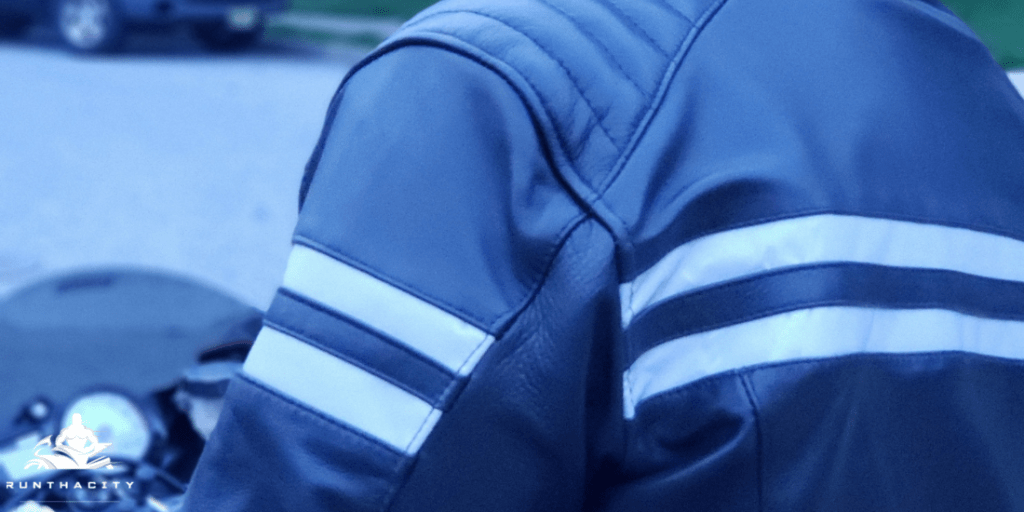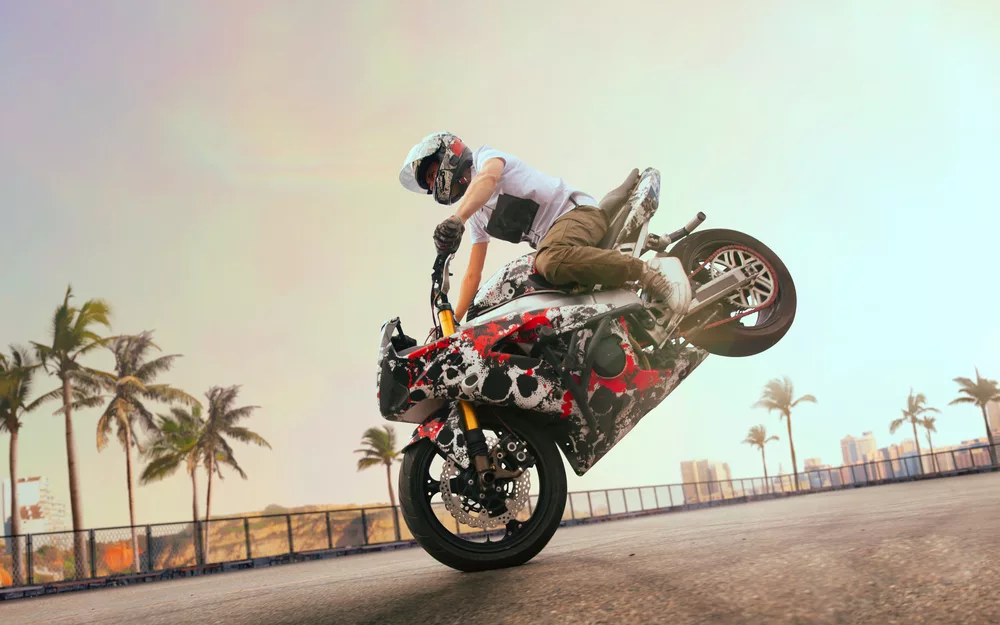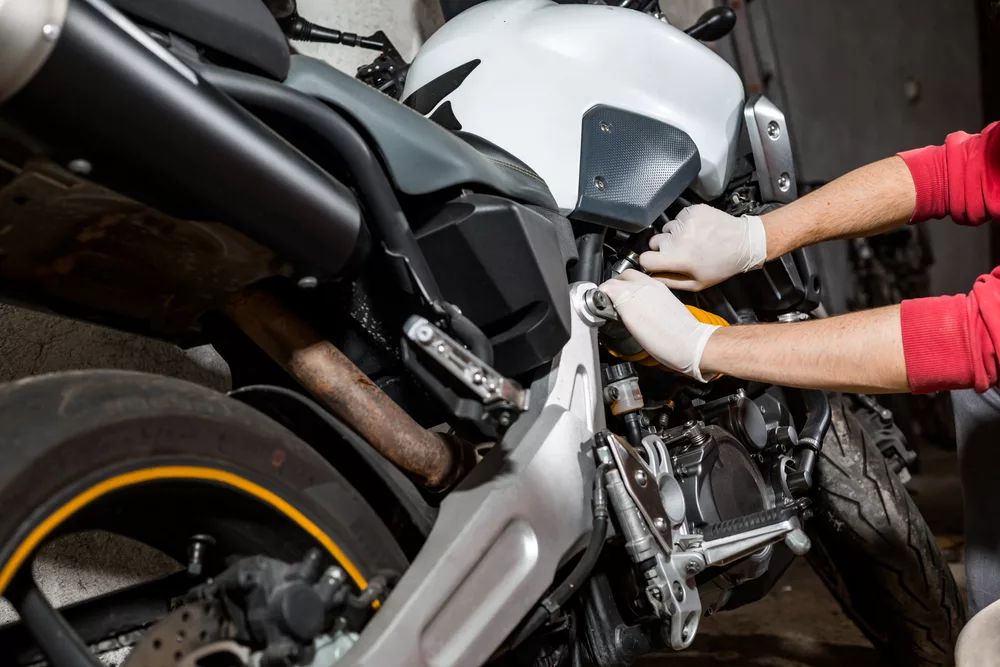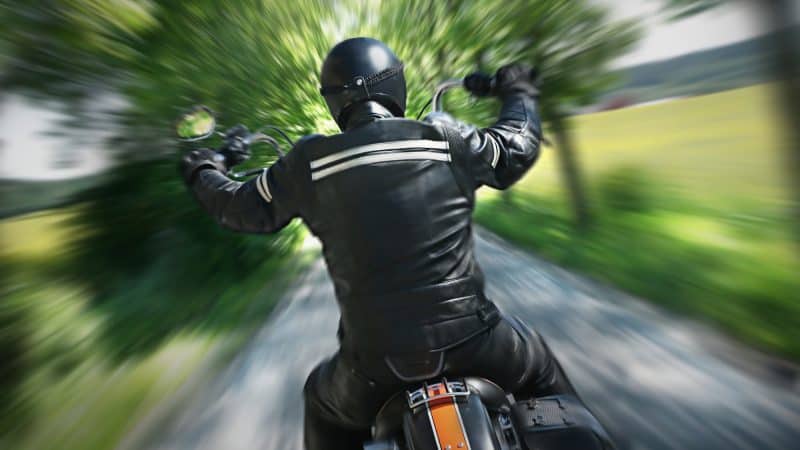When it comes to motorcycle jackets, you want something that balances the need to look like you own the road and enough protection to keep you from becoming part of the road. Viking Cycle, a brand based out of California, has been turning heads with their attention to detail and security in their full range of motorcycle clothing for men and women. The best part is the price tag.

Overview of the Bloodaxe Motorcycle Jacket
Out of the box, the Bloodaxe looks awesome and feels awesome. When the jacket first goes on, you’ll notice it’s a bit stiff—but it does loosen up with some wear, as good leather should. The zippers have solid construction, open and close smoothly, and lay well when you’re riding.
The biggest advantage of the Viking Cycle Bloodaxe isn’t the awesome name but the amount of storage. You won’t believe the amount of storage space you have with this jacket. There’s so much, it’s almost ridiculous.
There is a headphone wire system that you can feed into the collar of the jacket, earphone pockets, a media player pocket, cellphone pocket with 3 second access, 2 knife and pen pockets, an eyeglass pocket, a pocket designed to find a 10-inch tablet, extendable keyholder, and another pocket that can fit travel documents and your wallet. The pockets have a unique “no bulge” design, so even if you somehow managed to stuff every single compartment this jacket has, it will still look flat and sleek and not like a bubble jacket. Overall, it sits nice on the body and doesn’t feel stifling.
The sizing does run a little small. Someone around 5 foot, 10 inches, 180 pounds will fall into the M-L range, depending on how much you want to bundle up. If you take out the thermal lining or don’t want to wear a lot of clothing underneath, you might want to size down to prevent the jacket from floating on you.
No products found.
No products found.
Specifications
(listed adapted from vikingcycle.com)
- Construction – Drum-dyed soft genuine cowhide leather (milled buffalo), padded shoulders, and Viking cycle level 1 removable “armor” on elbows and spine; two intake vents on the top of the shoulders and exhaust vents in the back
- External Storage – 2 zippered chest pockets, 2 zippered side pockets, and a single sleeve pocket
- Internal Storage – 2 secured zippered pockets and a secret compartment
- Adjustability – waist snaps and sleeve zippers
- Visibility – High viz stripes located on the back and shoulders
Pros
- Sag and wrinkle resistant
- Wind and water resistant
- Abrasion resistant
- A ton of hidden pockets on the internal side of the jacket
- CE marked armor in the back and shoulders – comfortable and stays in place while riding around
- Budget-friendly cost without a lack of quality and safety
- Stylish design
Cons
- Can be hot – the jacket has a thermal lining and is heavy, so it can be oppressive in the summertime even with the vents open. For that reason, it might not be ideal for moving in slower paced traffic;
- CE armor level could be higher.
Warranty Info
Viking Cycle offers a 1 year manufacturer’s warranty on all of their products. This means that any defects or imperfections that you find are covered. The warranty does not cover wear and tear or damages caused from improper care.
This might raise some questions about durability, since some production errors or faults can take a few days or weeks to appear.
If you start to notice something odd going on with the jacket that you didn’t cause, you can contact Viking Cycle at info@vikingcycle.com with the order number and a photo of the defect to get an exchange or refund.
No products found.
Conclusion
Honestly, for the quality of the jacket, you would expect to pay more for it than you do. The name might be a bit for metal than what this motorcycle jacket offers, but the sleekness of the design, paired with the sound construction and unheard of amount of storage makes it a clear winner. If you’re looking for a balance of style and safety without breaking your bank, I recommend the Viking Bloodaxe motorcycle jacket for your wardrobe.
Looking for more details about choosing motorcycle jackets and other riding gear? Then check out and subscribe to my YouTube channel today!
No products found.
No products found.
You Might also like
-
How to Ride a Motorcycle in the Rain
Be it a shower or deluge, rain can be your worst nightmare when on a motorcycle if you’re not properly prepared. During the spring and winter months, precipitation is unpredictable, and if you are in a rainy state, expect to get caught at least one shower while riding your bike. Rather than avoiding rainy days altogether, learn to ride your motorcycle in the rain.
Before The Ride
For maximum safety, inspect your bike to make sure it’s ready to tackle a ride in the rain.
• Fluids: Check your motorcycle to make sure there’s no brake fluid or oil leakage. While oil leaks aren’t very dangerous in dry conditions, when oil mixes with water, the road becomes a slick and dangerous course.
• Brakes: Make sure the brake pads have enough material left to help you with prompt stops in wet conditions.
• Tires: Check that your tires have enough tread to push water away and grip the road. You also want to ensure they have enough air pressure. Under or over-inflated tires react differently in water, but both are potentially dangerous.Weatherproof Gear
In order to keep you and your bike safe, you should have the correct riding gear and attire ready to go. You can choose between water-resistant and waterproof items. Water-resistant will shed water, but after a period of time, water will begin to permeate the material. Waterproof, on the other hand, will never allow for water to absorb into the material, unless you get completely submerged in water.
• Water-resistant or Waterproof Gear: Jackets and one piece suits should be zipped up tightly when riding in the rain to prevent water from seeping. Zippers should have a flap that covers the edges to protect the interstices. Cuffs on the jacket or coat need to be long enough to reach your gloves.
• Riding Boots and Gloves: More effective deterrents against complete saturation of your clothes. Both boots and gloves need to be tight enough to prevent water from dripping through. No one likes cold, wet socks.
• Helmets and Goggles: For the best protection, get a full-faced helmet. If you have a ½ or ¾ face helmet, get a pair of goggles. Pair the goggles with a waterproof balaclava that can shed water away from your face.
• Miscellaneous: If you have a saddlebag or storage unit, consider keeping a change of dry clothes with you. Also, keep plastic bags with you to keep valuables dry if you happen to get caught in a sudden rainstorm. Dry bags or waterproof backpacks can also help.Be Cautious Of Road Conditions
Wet roads are dangerous for motorcyclists and other vehicle drivers, regardless of how prepared you may be. Even when the roads appear clean, they could be slick from oil. Here are some things to consider when traveling by motorcycle in the rain:
Less Traction
The first hour of rainfall is the most dangerous, because oils absorbed into the asphalt rise to the surface. During this time, it’s best to pullover at a rest stop about wait for about an hour. Once the rain has washed the road of oil and debris, you can head out again. Remember that this also means an increased braking distance.
Less Visibility
Sometimes, the fog or mist is too dense, or the rain is falling so hard you or other drivers can’t see. You can make yourself more visible to the traffic around you by wearing high visibility clothing and reflective patches.
Hydroplaning Risk
Hydroplaning occurs when water prevents the tire from making contact with the road. Reduce the risk of hydroplaning by avoiding painted lines, manhole covers, iridescent patches on the road and puddles (oil), tar snakes, metal crossing, and other places with reduced traction.
Also, you should reduce your speed when approaching puddles you can’t maneuver around. Start slowing down, squeeze the clutch, then coast through the puddle. If you’re going too fast, it’s better to maintain that velocity rather than slowing down abruptly, as this will reduce friction could cause fishtailing.
Decrease the risk of hydroplaning further with all-weather tires.Nature’s Wrath
Stay aware of lightning, hail, ice, sleet, and other conditions that could transpire in a rainstorm. High winds can cause debris to fall into the road, and you might not see it due to decreased visibility. If it starts lightning, pull over.
Conclusion
Not every day is going to be perfect riding weather. Planning ahead and being prepared goes a long way when dealing with rainy conditions. Not only will you stay dry, but you will arrive at your destination safely.
Want more riding tips? Head over to my YouTube channel. Subscribe to receive notifications and never miss an update. -
Tips for Buying Your First Sportbike
Sportbikes are fast, flashy, and fun, but they are also complex machines that require a significant investment of time and money. Before you buy your first sportbike, it’s important to consider the following tips to make an informed decision and find the right bike for your needs.
Consider Your Riding Style:
Before you start shopping for a sportbike, it’s important to determine what type of riding you want to do. Do you want to push the limits of your bike on a racetrack or do you want a bike that’s comfortable for long-distance touring? Here are a few different styles of sportbikes to consider:
- Track-focused sportbikes: These bikes are designed for high-speed, aggressive riding on a racetrack. They have powerful engines, lightweight frames, and advanced suspension systems. They are not recommended for daily street riding as they are not well-suited for comfort and practicality.
- Street-oriented sportbikes: These bikes are designed for fast and nimble street riding. They are lightweight, have powerful engines, and are typically more comfortable than track-focused sportbikes. They are ideal for riders who want a sporty and fun riding experience on public roads.
- Sport-touring bikes: These bikes are designed for long-distance riding and offer the best of both worlds: performance and comfort. They are equipped with large fairings, windscreens, and comfortable seats, making them ideal for riders who want to cover long distances in comfort.
By considering your riding style and the type of riding you want to do, you’ll be able to narrow down your options and find the right sportbike for your needs.
Set Your Budget:
Sportbikes can be expensive, and the cost of ownership goes beyond just the purchase price. Before you start shopping, it’s important to set a budget and consider the ongoing costs of ownership, including insurance, maintenance, and upgrades.
Here are a few tips to help you stay within your budget:
- Determine how much you can afford to spend: Consider your monthly income and expenses, and determine how much you can comfortably afford to put towards your sportbike.
- Factor in insurance costs: Insurance is an essential part of owning a sportbike, and the cost can vary greatly depending on the type of bike and your location. Research insurance rates before you buy, and factor these costs into your budget.
- Plan for maintenance costs: Sportbikes require regular maintenance, and the costs can quickly add up. Make sure to factor in the cost of oil changes, tire replacements, and other routine maintenance items into your budget.
- Consider the cost of upgrades: Many sportbike owners like to make upgrades to their bikes, and the costs can quickly add up. Consider the cost of upgrades and factor these into your budget before you buy.
Remember, the most expensive bike is not always the best, and there are many affordable options that offer excellent performance and value. By setting a budget and considering the ongoing costs of ownership, you’ll be able to find the right sportbike that fits your needs and your budget.
Find the Right Size:
When buying a sportbike, it’s important to find the right size and fit to ensure maximum comfort and control while riding. Here are a few tips to help you find the right size:
- Consider your height, weight, and inseam length: The size of a sportbike can greatly affect how comfortable and in control you feel while riding. Use your height, weight, and inseam length to determine which bikes might be the right size for you.
- Test-ride several models: The best way to determine the right size is to test ride several different models. This will give you a chance to get a feel for each bike and see how well it fits you.
- Check the seat height: When test riding, pay attention to the seat height. You should be able to comfortably reach the ground with both feet while seated on the bike.
- Consider the reach to the handlebars: The reach to the handlebars is also important, as it affects your comfort and control while riding. Make sure the reach is comfortable and that you can easily reach the controls.
- Check the weight: The weight of a sportbike can greatly affect how comfortable and in control you feel while riding. Be sure to take note of the weight of each bike you test ride and consider how it affects the overall feel of the bike.
By considering your height, weight, and inseam length, and test riding several models, you’ll be able to find the right size and fit for your needs and ensure maximum comfort and control while riding your sportbike.
Inspect the Bike Carefully
Before you buy a sportbike, inspect it carefully for any signs of damage or wear. Check the wheels, tires, brakes, and suspension for any signs of damage, and make sure the engine runs smoothly and quietly. If you’re unsure about anything, have a mechanic inspect the bike before you make a purchase.
Additionally, pay attention to the bike’s overall appearance. Look for any signs of rust or corrosion, especially in areas such as the exhaust pipes, frame, and suspension components. Check the battery to make sure it holds a charge and has enough power to start the engine. Test the bike’s electrical system to ensure all lights, signals, and gauges are working properly. Check the air filter and oil level, and make sure the bike has been properly maintained and serviced according to the manufacturer’s guidelines.Another important aspect to consider is the bike’s history. Make sure to request a vehicle history report to determine if the bike has been in any accidents, or if it has a clean title. If you’re buying a used bike from a dealer, ask about the previous owner and if the bike has been well taken care of. If you’re buying from a private seller, be cautious and take a close look at the bike to see if it has any signs of abuse or neglect.
It’s also important to test ride the bike before making a purchase. This will give you a good feel for the bike’s handling, braking, and acceleration. Take the bike on different types of roads, including highways, twisty roads, and stop-and-go traffic, to get a good idea of how it handles different conditions. This will also help you determine if the bike is comfortable for you and if it’s the right size and fit for your needs.
In summary, thoroughly inspecting a sportbike before making a purchase is a critical step in ensuring you’re getting a high-quality, reliable machine that will provide you with years of riding enjoyment.
Research the Model and Brand
When researching a sportbike, it’s important to take a deep dive into the model and brand you’re interested in. This will give you an understanding of the bike’s history, reliability, and any common problems riders have experienced. Start by reading reviews from trusted sources to get a better understanding of the bike’s strengths and weaknesses. You can also visit online forums and read what other riders have to say about their experiences with the bike. Ask questions and take note of any common complaints or issues that have been raised. This information can be invaluable in helping you make an informed decision. Additionally, consider reaching out to the manufacturer or a dealership to learn about any current or upcoming models that may interest you. It’s always a good idea to do your due diligence before making a big purchase, and researching the sportbike you’re interested in is a key step in that process.
Conclusion
In conclusion, when it comes to buying your first sportbike, there are many factors to consider. From determining your riding style and setting a budget, to finding the right size and fit, and carefully inspecting the bike before making a purchase, each step is important in ensuring you make the right choice for your needs. Additionally, researching the model and brand you are interested in will give you valuable insight into the bike’s history, reliability, and common problems. With this information, you will be able to make an informed decision and enjoy many years of thrilling riding. Don’t be afraid to take your time and shop around, the right sportbike is out there waiting for you. Happy riding!
-
What Every Rider Should Know About Road Rash
Road rash isn’t a punchline to a joke about bad motorcycle handling or old video game. Road rash, also called “friction burn,” is a serious injury. The severity of the wound is measured by degrees, the same as you would a chemical or fire burn. Since the skin is the largest organ of our bodies, getting road rash opens you up to other vulnerabilities, such as infection. But there is more to understand about road rash than these points.
Let’s look at this serious injury that can happen to anyone and learn how to classify and treat various types of road rash.
The Different Types of Road Rash
Not every bout of road rash is created equal. There are three main types of road rash:
- Avulsion – the skin is scraped away. Sometimes fat, muscle, and even bone will be exposed.
- Compression – where the body is caught between two objects, such as the motorcycle and the road. This results in bruising, broken bones, and damaged muscle.
- Open wound – usually require stitches. Open wound road rash might even require skin grafting.
Aside from the 3 different types, there are 3 degrees of damage:
- First degree – the first layer of the skin is red. Does not require medical treatment and will heal well enough on its own.
- Second degree – the first layer of skin, known as the epidermis, is broken. There can be bleeding and debris stuck in the wound. Usually requires little medical treatment and can heal with no scarring or lasting damage.
- Third degree – skin has been peeled away, leaving tissue, fat and sometimes bone exposed. Victims often need skin grafting.
The degrees of the crash depends on factors such as the force of the impact with the ground, the type of surface where the crash takes place, and whether safety gear was equipped.
Road rash will often occur in places that come in contact with the abrasive surface, either when attempting to catch oneself or when rolling or getting dragged. The outside of the legs, knees, palms, thighs, shoulders, and face are usually where road rash occurs.
Complications of Road Rash
Seek medical treatment immediately if you experience any of the following with road rash:
- Severe pain
- Inability to move affected region
- Cuts on the face that are larger than a ¼ inch
- Cuts on the body that are larger than a ½ inch
- Bleeding doesn’t stop
- Gaping wound remains opened with you relax the body
- Fat is visible in the exposed tissues
- Road rash is paired with other injuries, including possible concussion or broken bones.
Any open wound should be treated with antibiotics within six hours. Otherwise, you are at risk of infection.
Treatment and Recovery From Road Rash
Depending on the severity of the road rash, you can oftentimes treat it yourself. In that event, do the following:
- Stop any bleeding.
- Wash your hands with soap and water.
- Rinse the wound thoroughly.
- Wash the wound with soap, water, and then use some witch hazel.
- Apply a topical antibiotic.
- Bandage the wound.
- Change the dressing.
Note: During the recovery, the skin will undergo healing from the deepest layers to the top. It might get scabs. Do not pick the scabs. Instead, continue changing the bandages and applying topical antibiotics. Once the oozing stops, you can use petroleum jelly to keep the skin supple and lessen the scarring.
If you end up going to the doctor because of a deep wound, the medical professional might recommend using ibuprofen, a non-steroidal anti-inflammatory drug (NSAID), acetaminophen, or naproxen to deal with the pain.
Remember that because the skin has been opened by abrasion, you could be at risk for infection. Consider getting a tetanus shot. Tetanus boosters last 10 years, so if you had an injury where the epidermis or dermis of the skin has been injured, tetanus bacteria can enter the wound. At any time symptoms of infection begin, such as redness, swelling, warm or hot skin around the injury, tenderness, pain, or bloody ooze or yellowish pus, you could have an infection. Make sure to get to a doctor immediately.
Hopefully, you should now have an understanding of road rash and how serious it can be. Don’t ignore severe injuries after a fall. Drive safe and stay safe, so you can keep riding!











